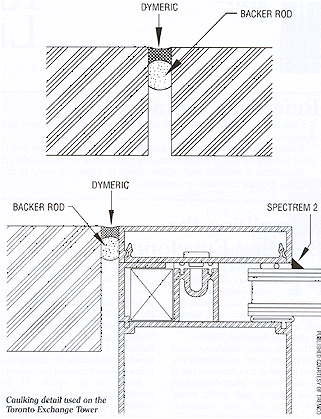Many of the great towers of our city’s core are maturing, and the instruments of exterior remedial work, such as scaffolding and swing stages, are becoming, increasingly, a common summer view from the streets in downtown Toronto.
These building envelopes must endure a very harsh environment year round including: the ultra violet rays of the sun; acid rain; carbon dioxide from vehicle exhaust; high winds; freeze-thaw cycles; and, even mechanical abuse from window washing activities. The 35 storey Exchange tower, built in 1980, is a well recognized and respected structure located in the heart of Toronto’s business and financial district.
The building owner, with the assistance of the building management company, Brookfield Management Services Ltd., have decided to take a pro-active approach towards the upkeep and revitalization of the Exchange Tower’s building envelope.
During the initial stages of the plan, Engineering Investigations were performed on the building roofs and walls in order to determine the current condition of these important components.
Based on the results of the Investigations, it was determined that remedial revitalizing measures were warranted in order to ensure the longevity of the building envelope and to retain the prestigious exterior appearance of the building.
It should be pointed out that, although some of the building envelope components were in need of remedial work, water leakage was not yet a problem at this building.
The revitalization program included two major components: roofing rehabilitation; and, recaulking and cleaning of the entire exterior wall system.
The next stage in the process included the preparation of detailed specifications and drawings for the complementary Projects. In this article we will focus on the recaulking portion of this Project. Caulking is a material that is becoming more and more complex due to the fact that it is expected to perform a wide range of functions and work together with almost every known material a Designer puts into their envelope design.
Caulking is typically used at the interface of each module of a given material and between different materials and different systems. The caulking must, therefore, be able to adhere to all of the materials as well as be able to move (i.e., expand, contract, bend, stretch) on a regular basis as the building and its components move. It must be understood that buildings, and especially building envelopes, although they appear to be static, are actually constantly moving (i.e., they are dynamic). For example, a length of aluminum capping can easily expand or contract 12 mm (1/2″) as the sun heats its surface during a sunny day.
Each building envelope has its own micro-climate that complicates matters even more. The materials that make up the wall and window systems, their colours and orientation, all affect the overall performance of the envelope and the caulking.
During the development of the Specifications for the recaulking of the Exchange Tower, numerous tests and mock-ups were made in order to determine the most appropriate materials and their installation procedures. Adhesion and compatibility tests were made at each joint type and numerous primers, backer rods, and bond breaker tapes were reviewed in order to design proper joints. There are numerous factors including: joint width; expected movement of the joint; joint depth; and, the actual make-up of the materials on each side of the joint. To complicate matters even more, the make-up of the previous caulking and any hidden materials behind the joint or panel must also be analyzed to ensure there is no adverse reaction.
A proper recaulking Specification for a particular building will detail each and every joint configuration as well as the exact materials and installation procedure.
The final stage of a recaulking project is the actual construction. It is during this stage that many Projects fail due to misunderstandings in the procedure, or due to improper preparation and installation. Due to the fact that recaulking is extremely labour intensive, it is always cost-effective to use only premium products. It is, therefore, imperative that the materials be installed, as specified.
The recaulking of the Exchange Tower involves many operations including: the removal of the existing caulking and backer materials; the preparation of the surfaces for the new materials; the insertion or attachment of specially designed backer materials that assist in the joint configuration; and, actual application of the caulking. In many cases, additional activities include the masking of adjacent materials and other cosmetic tasks.
During the actual construction phase of the Project, on-going testing is essential in a recaulking Project. It is also important to check the material on an on-going basis to ensure it was mixed properly. The recaulking and cleaning of the exterior walls of the Exchange Tower will have been completed within a three months time frame. The entire process of assessment, design, including the Tendering process, and management of the actual remedial work, will have been performed over a period of seven months.

Written by: Keith Bryant, Principal and Director of Technical Operations
ENERPLAN BUILDING CONSULTANTS.
Republished from the September 1997 issue of Canadian Property Management Magazine
with the permission of the writer and Media Edge Communications.

No Comments